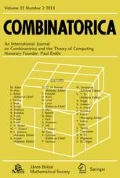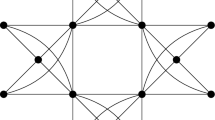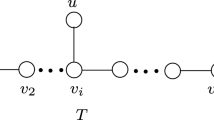Abstract
Let L be a given family of so called prohibited graphs. Let ex (n, L) denote the maximum number of edges a simple graph of ordern can have without containing subgraphs from L. A typical extremal graph problem is to determine ex (n, L), or at least, find good bounds on it. Results asserting that for a given L there exists a much smaller L*⫅L for which ex (n, L) ≈ ex (n, L*) will be calledcompactness results. The main purpose of this paper is to prove some compactness results for the case when L consists of cycles. One of our main tools will be finding lower bounds on the number of pathsP k+1 in a graph ofn vertices andE edges., witch is, in fact, a “super-saturated” version of a wellknown theorem of Erdős and Gallai.
Similar content being viewed by others
References
C. Benson, Minimal regular graphs of girth eight and twelve,Canadian J. Math. 18 (1966) 1091–1094.
J. A. Bondy andM. Simonovits, Cycles of even length in graphs,Journal of Combinatorial Theory,16 (1974) 97–105.
W. G. Brown, On graphs that do not contain a Thomsen graph,Canadian Math. Bull. 9 (1966) 281–285.
W. G. Brown, P. Erdős andM. Simonovits, Algorithmic solution of extremal digraph problems,to be published.
D. Cvetković, M. Doob andH. Sachs,Spectra of graphs — Theory and Application — VEB Deuthscher Verlag der Wissenschaften, Berlin, 1980.
P. Erdős, On sequences of integers no one of which divides the product of two others, and some related problems,Mitt. Forschunginstitut Math. u. Mech. Tomsk 2 (1938) 74–82.
P. Erdős, Graph theory and probability,Can J. Math. 11 (1959) 34–38.
P. Erdős, A. Rényi andV. T. Sós, On a problem in graph theory,Studia Sci. Math. Hungar. 1 (1966), 215–235.
P. Erdős andM. Simonovits, A limit theorem in graph theoryStudia Sci. Math. Hungar. 1 (1966) 51–57.
P. Erdős andM. Simonovits, Supersaturated graphs,submitted to Combinatorica.
G. R. Blakley andP. Roy Hölder type inequality for symmetric matrices with nonnegative entries.Proc. AMS 16 (1965) 1244–1245.
R. J. Faudree andM. Simonovits, On a class of degenerate extremal problems,submitted to Combinatorica.
T. Kővári, V. T. Sós andP. Turán, On a problem of Zarankiewicz,Coll. Math. 3 (1954) (50–57).
I. Reiman, Über ein problem von Zarankiewicz,Acta Acad. Sci. Hungar. 9 (1958) 269–279.
R. Singleton, On minimal graphs of maximum even girth,J. Combin. Theory 1 (1966) 306–332.
P. Turán, On an extremal problem in graph theory, (in Hungarian),Mat. Fiz. Lapok 48 (1941) 436–452.
D. London, Inequalities in quadratic forms,Duke Math. J. 83 (1966) 511–522.
H. P. Mulholland andC. A. B. Smith, An inequality arising in genetical theory,Amer. Math. Monthly 66 (1969), 673–683.
Author information
Authors and Affiliations
Additional information
Dedicated to Tibor Gallai on his seventieth birthday
Rights and permissions
About this article
Cite this article
Erdős, P., Simonovits, M. Compactness results in extremal graph theory. Combinatorica 2, 275–288 (1982). https://doi.org/10.1007/BF02579234
Received:
Issue Date:
DOI: https://doi.org/10.1007/BF02579234




